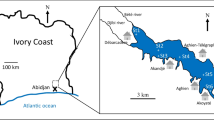Abstract
The Patos Lagoon is the largest lagoonal system in South America. Its waters are formed by a huge drainage basin (201,600 km2) situated in the most industrialized areas of the Southern state of Rio Grande do Sul. On its margins more than 3 million inhabitants live in several cities and towns. The lagoon waters are used for leisure, drinking, industry, fisheries, agriculture and navigation. A monitoring and sampling program was developed from February 1994 to January 1996 with emphasis on the estuarine area, aiming to evaluate the occurrence of algal blooms. In the last 15 years, several cyanobacterial (blue-green algal) blooms of theMicrocystis aeruginosa have been registered in the lagoon estuary. HighM. aeruginosa biomass (50 to 9,000 μg chla l−1) was observed in the whole region in late summer and autumn 1994, and early summer 1995. The LD50 of toxic bloom samples tested in mice varied from 22 to 250 mg dry weight kg body weight−1 while levels of toxicity (LC50) in the brine shrimp varied from 0.47 to 2.44 mg ml−1. Toxicity varied in different blooms, in the distances along the scum and with time, within the same bloom. The hepatotoxin microcystin-LR was identified in almost all samples.
Similar content being viewed by others
References
Bell, S.G. & G.A. Codd, 1994. Cyanobacterial toxins and human health. Rev. Med. Microbiol. 5: 256–264.
Campbell, D.L., L.A. Lawton, K. Beattie & G.A. Codd, 1994. Comparative assessment of the specificity of the brine shrimp and Microtox assays to hepatotoxic (microcystin-LR-containing) cyanobacteria. Envir. Toxicol. Water Qual. 9: 71–77.
Carmichael, W.W., 1986. Algal toxins. In: J.A. Callow (ed.),Advances in botanical research. pp. 47–101. Academic Press, London.
Carmichael, W.W. & I.R. Falconer, 1993. Diseases related to freshwater blue-green algal toxins and control measures. In: I.R. Falconer (ed.),Algal toxins in seafood and drinking water. Chapter 12. Academic Press, London.
Codd, G.A. & K. Beattie, 1991. Cyanobacteria (blue-green algae) and their toxins: awareness and action in the United Kingdom. Public Health Lab. Ser. Microbiol. Digest. 8: 82–86.
Elder, G.H., P.R. Hunter & G.A. Codd, 1993. Hazardous freshwater cyanobacteria (blue-green algae). Lancet 341: 1519–1520.
Hamilton, M.A., R.C. Russo & R.V. Thurton, 1977. Trimmed Spearman Karber method for estimating median lethal concentrations in toxicity bioassays. Environ. Sci. Technol. 11: 714–719. Correction: Environ. Sci. Technol. 12: 417.
Harwig, J. & P.M. Scott, 1971. Brine shrimp (Artemia salina) larvae as screening systems for fungal toxins. Appl. Microbiol. 21: 1011–1016.
Lawton, L.A., D.L. Campbell, K.A. Beattie & G.A. Codd, 1990. The use of a rapid bioluminescence assay for detecting cyanobacterial microcystin toxicity. Lett. Appl. Microbiol. 11: 205–207.
Lawton, L.A., C. Edwards & G.A. Codd, 1994. Extraction and high-performance liquid chromatographic method for the determination of microcystins in raw and treated waters. Analyst 119: 1525–1530.
Mackinney, G., 1941. Absorption of light by chlorophyll solutions. J. Biol. Chem. 140: 315–322.
Odebrecht, C., U. Seeliger, R. Coutinho & L.C. Torgan, 1987. Florações deMicrocystis (cianobactéria) na Lagoa dos Patos, RS. Pap. Pres. Simp. Ecos. Cost. Sul e Sud. Bras.: Sínt. Conh. Cananéia, S.P., April 11–16.
Robarts, R.D. & T. Zohary, 1992. The influence of temperature and light on the upper limit ofMicrocystis aeruginosa production in a hypertrophic reservoir. J. Plankton Res. 14: 235–247.
Skulberg, O.M., G.A. Codd & W.W. Carmichael, 1984. Toxic blue-green algal blooms in Europe: a growing problem. AMBIO 13: 244–247.
Skulberg, O.M., W.W. Carmichael, G.A. Codd & R. Skulberg, 1993. Taxonomy of Toxic Cyanophyceae (Cyanobacteria). In: I.R. Falconer (ed.),Algal toxins in seafood and drinking waters. Chapter 9. Academic Press, London.
Torgan, L.C., 1989. Ahálise expedida. Fundação Zoobotânica do RS. Museu de Ciências Naturais, Porto Alegre, 2 pp.
Utkilen, H. & N. Gjolme, 1992. Toxin Production byMicrocystis aeruginosa as function of light in continuous cultures and its ecological significance. Appl. Environm. Microbiol. 58(4): 1321–1325.
Van der Westhuizen, A.J. & J.N. Eloff, 1983. Effect of culture age and pH of the culture medium on the growth and toxicity of blue-green algaMicrocystis aeruginosa. Z. Pflanzenphysiol. Bd. 110(2): 157–163.
Van der Westhuizen, A.J., J.N. Eloff & G.H.J. Krueger, 1986. Effect of the temperature and light (fluence rate) on the composition of the toxin of the cyanobacteriumMicrocystis aeruginosa (UV 006). Arch Hydrobiol. 108 (2): 145–154.
Yunes, J.S., C. Odebrecht, L.F.H. Niencheski & G.A. Codd, 1992. Efeito do balanço de nutrientes e de fatores físicos na ocorrência de florações de cianobactéria. Pap. Pres. 2nd Enc. Ecotoxicol. Rio Grande, Brazil, December 3–4.
Yunes, J.S., L.F.H. Niencheski, P.S. Salomon. M. Parise, K.A. Beattie, S.L. Raggett & G.A. Godd, 1994. Development and toxicity of cyanobacteria in the Patos Lagoon estuary, Southern Brazil. IOC Workshop Report, 101. annex III, COI/UNESCO Publ.: 14–19.
Author information
Authors and Affiliations
Rights and permissions
About this article
Cite this article
Yunes, J.S., Salomon, P.S., Matthiensen, A. et al. Toxic blooms of cyanobacteria in the Patos Lagoon Estuary, southern Brazil. Journal of Aquatic Ecosystem Health 5, 223–229 (1996). https://doi.org/10.1007/BF00662183
Received:
Accepted:
Issue Date:
DOI: https://doi.org/10.1007/BF00662183




